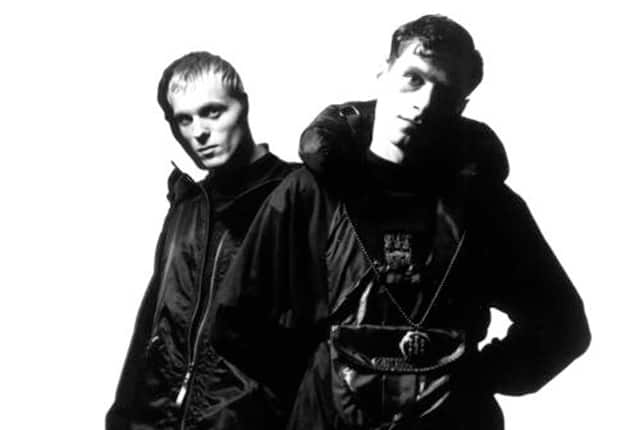Since their beginnings in 1986, change has been no stranger to The Shamen. Originally an indie-rock outfit from Aberdeen, Scotland, the band relocated to London a few years later and became heavily influenced by the acid house scene.
But 1991 was a pivotal year for the group – they finally broke in America, went top 40 in Britain and lost one of their founding members. Last year, The Shamen regrouped and released a new album, “Boss Drum,” an LP that finally realizes their full potential as a dance outfit.
https://www.youtube.com/watch?v=SBy6SkT6Qes
The Shamen’s interests in dance music first became evident after the “Drop” LP. Previous to this, the group had been using synths and primitive samplers in their music, but it wasn’t until The Shamen started hearing hip-hop and electro music that they began using the technology to create a dancier sound. The group’s original drummer, Keith, was a major influence in bringing these styles into The Shamen sound. Relocating to London in 1988 and becoming immersed in the acid house scene completed the band’s transition.
Psychedelia has always been part of The Shamen, and that’s what attracted them to acid house. “I could recognize the psychedelic aspects of the music immediately, but it was irresistibly danceable,” says frontman Colin Angus referring to the spacey sound of classic analogue synths used in the songs. “And the reports I was hearing about the parties, the multi-media events very like what I imagine events were like in the 60’s in terms of massive light shows with strobes and oils and colored lights and lots of people enjoying the company of one another in a psychedelically enhanced atmosphere or empathy of love.”
“Move Any Mountain”, a reworked version of their 1990 club anthem “Pro-Gen,” was the song that finally introduced The Shamen to mass audiences both here and abroad. The song was remixed by so many people that the band had more mixes than they knew what to do with, so they released it as a limited edition double album called Progeny. The lp went straight to #21 on the British album charts, disappearing a few weeks later when all the copies were gone.
“Electronic music is such a powerful way of composing and such a powerful way for two artists to interface in each other work, as this album hopefully shows,” explains Angus. “We were making a point to the people buying the record ‘well what exactly is the definition of a track these days.”
The Shamen even went so far as to include the individual samples so that fans could create their own mixes (these also appeared on the US single of the sound). The group found itself flooded with new mixes when it went on the road, and the breakbeat can be heard on the Utah Saint’s “Something Good.”
1991’s “En-tact” was the Shamen’s breakthrough LP in the States, but the American issue differs from the original UK version, which was released in November of 1990. Tracks were remixed by various people, including the Shamen themselves, who say they were getting bored with some of them. Angus feels that the resulting package was superior to the original. “I think there’s a greater diversity among the tracks, it’s a lot more polished and more danceable,” he says.
Sadly, co-founder Will Sin did not live to see his band finally make it big. When the group traveled to Tenerife to shoot a video for the new version of “Move Any Mountain,” Sin drowned at the age of 31. But The Shamen continued on as a duo of Angus and rapper Mr. C, a long-time collaborator who had recently been made a full-time member of the band.
“When it first happened, I was still reeling from the shock of Will’s completely unexpected and tragic death, and I couldn’t think about the Shamen at all, couldn’t see how anything could continue,” says Angus. “But as I came to terms with it and thought about the situation I realized that what the Shamen’s about was positivity and that positivity is like the spirit of the music and positivity acknowledges the need for change. So for those reasons I elected to carry on and also I knew that the name Shamen really meant a lot to Will and that was one of the main attractions for joining the band for him.”
Angus adds that he could not let the Shamen fall into history because it is “such an informative name.”
“Once you start delving into what Shamanism is, and Shamanism is definitely on the rise worldwide, we realized that it’s such a powerful excuse for putting forth that kind of information,” he says. “The Shamen must continue to exist as a band.”
On “Boss Drum,” the ideas of Shamanism figure prominently in the lyrics. The most extreme example is “Re-evolution,” on which Terence McKenna explains the relationship between house music/rave culture and the ancient beliefs of Shamanism, saying how the youth culture of the 90’s is leading to an “archaic revival”.
“We’re putting across the information of what Shamanism is, why the rhythm is important, why it is important to dance, the ideas about planetary consciousness and human evolution,” explains Angus. “We’ve put this across in the lyrics of most of the tracks, particularly the title track and ‘Re-evolution’.”
To support “En-tact,” the Shamen brought their “Progeny” show to America for their first-ever tour of this country. A continuation of the groups “Synergy” nights in London, the shows featured sets by The Shamen and Moby, in addition to a variety of DJs. Although on a smaller scale, these gave many Americans their first tastes of the all-night raves that have been going on in England since acid house hit. The aim is to make the audience feel like they’re part of the event, rather than just fans out to see a band. The group always goes out into the crowd and mingles after their set is over.
For the live shows, Angus says that the group breaks down their studio and re-creates it on stage. The Shamen run all of the sequencers live, adding keyboards, drums and guitar on top of it. “It’s quite a time-consuming set-up to reconstruct every night and a lot of work for the people making the music and for the man who’s mixing the sound,” explains Angus. “But it is a very, very live sound and that’s what sets us apart from other dance artists.”
The Shamen is currently a trio of Angus, Mr.C. and vocalist Jhelisa, formerly of Soul Family Sensation. Angus says that the line-up has worked out well and that he has been pleasantly surprised by the amount of collaborating he’s been doing with Mr. C. “Coming from a DJing background, he’s obviously sharpening up the rhythms,” he explains. “But on a lot of the raps he does, we’re actually working out the words for those together.”
All the vocal talent in the band creates a big difference between the sound of “En-tact” and “Boss Drum”. Angus no longer handles all the lead vocals, and on some tracks, such as “LSI,” the voices of all three are equally prevalent. As a whole, Boss Drum is a much stronger effort than En-tact due to more variety in the songs and a more dance-oriented sound. Angus explained that this time around less emphasis was placed on sampling and the group concentrated on creating their own rhythms and sounds, often going back to the classic analog synths that were the backbone of acid house.
The group sees themselves as more of a house band than a rave or techno act. Angus feels that the rave scene has lost a lot of its power, now that it is dominated by insanely fast hardcore techno. “The music has become far too fast for dancing to properly,” he explains. “It’s certainly become far too fast to be psychologically empowering – it doesn’t alter neurological states in the same way that music between 90 and 130 bpm does.”










